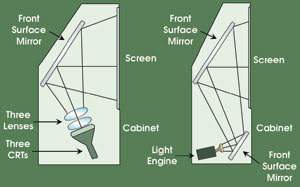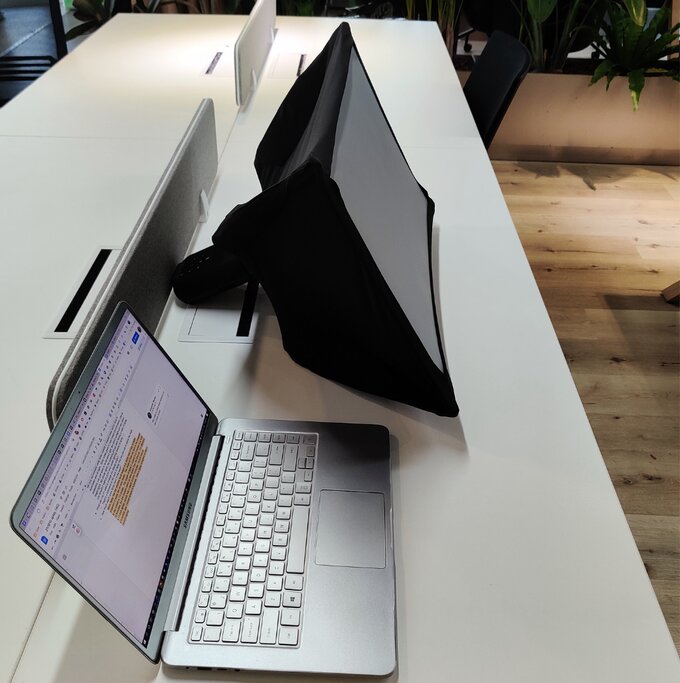I have to give a hat-tip to Jon Peddie for letting me know that the ‘Spud’ (the Spontaneous Pop-up Display), launched as a Kickstarter campaign back in 2016 is now back in a revised form as the ‘Splay’.

The Splay is a rear-projection ultra-short throw monitor designed to be collapsible and very portable with a battery. The display engine can also be used in ‘projector mode’ bu removing it from the hood. A significant change from the last version is a boost in resolution from 1280 x 720 up to FullHD. Before I get into the speeds and feeds, I wanted to briefly look at rear projection as a display method.
Rear projection was developed a long time ago for two key applications. One was in control rooms and rear-projection cubes (RPCs) are still being designed made and installed for that application. (Barco updated one of its products just last week) One of the key advantages of rear projection was that it allowed very, very close to zero bezel width meaning that it is possible to tile displays and build huge walls of nearly seamless appearance. Of course, you can do that with direct view LEDs as well, but that costs a lot more and takes more power. RPCs have taken advantage of new imagers and light sources to extend lifetime and efficiency.
 Image JDSUThe other big application was rear-projection TVs. In the days of CRTs, using three very bright CRTs and lenses allowed big TVs to be made when a huge CRT would have been very, very big, heavy and expensive. As other projection technologies came along, such as LCDs, LCOS chips and DLP, the CRTs were replaced with better imagers. However, the image quality was never quite as good as the direct view displays and when LCDs really tumbled in price, rear projection TV became a niche.
Image JDSUThe other big application was rear-projection TVs. In the days of CRTs, using three very bright CRTs and lenses allowed big TVs to be made when a huge CRT would have been very, very big, heavy and expensive. As other projection technologies came along, such as LCDs, LCOS chips and DLP, the CRTs were replaced with better imagers. However, the image quality was never quite as good as the direct view displays and when LCDs really tumbled in price, rear projection TV became a niche.
Rear Projection and Monitors
The idea of a rear-projection monitor is not new. TI was talking about it more than two decades ago when I visited the DLP group in Texas. As DLP production scaled up, TI was very ambitious to really drive up volumes and was targeting not just the volume TV market, but also desktop monitors. Prototypes were made and shown. I remember being at a big PC maker (I probably signed an NDA, so I shouldn’t say who!) at a display analyst’s event when a prototype was proudly wheeled out. At the time, like the others there, I made very positive noises about the potential in the market. However, on the plane home, I realised that I had been swept up in the mood of wanting to be nice to my hosts who had given us a great time. So I sent them an email saying that, on reflection, the image quality simply didn’t cut it to compete with TFT LCDs or CRTs, so I didn’t think the product would fly. I assume they came to the same conclusion, as the product never appeared on the market.
However, rear projection is still an interesting idea, as you can get a big image from a small imager. That’s useful if you are a road warrior. You can carry a pico-projector, of course, but then you need to carry a screen as well to get a good image. For typical monitor applications, you also want the display at a reasonable distance, at the right angle and close to the keyboard. That’s not easy to arrange in a hotel room, with a front projector.
So, the Spud was born in 2016 as a way to create a fold up device that was easy to carry, but acted like a real monitor. There was a Kickstarter project that went ahead. There are USB monitors available from firms such as Asus that plug into the USB ports of notebooks to get power and graphics data, but they tend to be limited to around the same size as the notebook display. The Splay 24.5″ diagonal so is monitor-like in size.
A Boost in Resolution
One downside of the original Spud is that the resolution was just 1280 x 720. Frankly, I haven’t used a monitor display with that low resolution for more than 30 years, so it immediately struck me as not a product I would ever buy. The Splay on the other hand goes up to FullHD, so has, just about, acceptable resolution for work and plenty for viewing media.
As well as the FullHD pico-projector, the Splay needs to have screen material that does not crease. That’s a challenge when it also has demanding optical requirements such as eliminating the traditional bright ‘hot spot’ from the projection engine. Arovia, which is behind the Kickstarter project, says its screens will stay wrinkle free however many times they are folded. The system also has to be easy to set up, so Splay has patented retractable arms that are durable and as easy to open as an umbrella, the firm said.
In terms of performance, the firm said that the surface brightness of the screen is 800 cd/m² and that’s bright (typical mainstream office monitors are around 200-250 cd/m²). In projector mode, it puts out 260 lumens. It should look good even in moderate ambient light. Without a close up viewing, I’m not sure how good the focus would be in the corners of the screen, but the optics in UST devices have improved a lot in recent years, with high volumes of UST-based projects shipping in education as well as for Laser TVs (mainly in China).
Still, for the Kickstarter early bird price of $675, the product looks like an interesting one for road warriors and the group has a track record of actually delivering (and my experience of Kickstarter technology products has not been good!). (BR)



